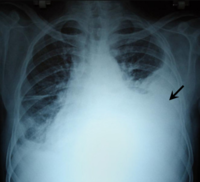
Photo from wikipedia
Colonic diverticular hemorrhage has been reported as the most common cause of lower gastrointestinal bleeding [1–3]. In colorectal diverticular hemorrhage, active bleeding, nonbleeding visible vessels, and adherent clot (indicating active… Click to show full abstract
Colonic diverticular hemorrhage has been reported as the most common cause of lower gastrointestinal bleeding [1–3]. In colorectal diverticular hemorrhage, active bleeding, nonbleeding visible vessels, and adherent clot (indicating active bleeding or nonbleeding visible vessels when removed) are defined as stigmata of recent hemorrhage (SRH) [4]. For SRH identification, blood clot removal and detailed examination of the responsible diverticulum are needed. However, use of the scope function alone is sometimes challenging; thus, a simple and effective method that helps to identify the SRH more precisely is required. A 65-year-old woman with hematochezia was admitted to our hospital. Colonoscopy revealed an adherent clot attached to the diverticulum in the ascending colon. The blood clot could not be removed by washing or suction using only an endoscope. Moreover, the diverticulum opening was too small to enable internal examination. Therefore, we used a nontraumatic tube (Olympus, Tokyo, Japan) designed for the pit diagnosis of colonic tumors by magnifying endoscopy [5]. The tip of the nontraumatic tube is small and spherical and includes a spray hole (▶Fig. 1). The tube can be inserted safely into the diverticulum owing to its shape. The blood clot can then be removed by repeated washing and suction via the spray hole (▶Fig. 2). After removing the blood clot in this way, we used the nontraumatic tube to expand the diverticulum opening, revealing an exposed blood vessel. Active bleeding was observed with further suctioning from the nontraumatic tube, indicating that this diverticulum was responsible for the hemorrhage (▶Fig. 3). Hemostasis was achieved using an over-the-scope clip at the diverticulum (▶Fig. 4). The patient was discharged without complications such as rebleeding or delayed perforation (▶Video 1). We believe that this novel nontraumatic tube method will contribute to the detection of blood vessels responsible for colonic diverticular hemorrhage and will facilitate the precise identification of an SRH.
Journal Title: Endoscopy
Year Published: 2021
Link to full text (if available)
Share on Social Media: Sign Up to like & get
recommendations!